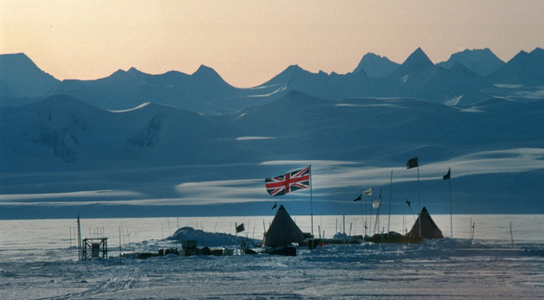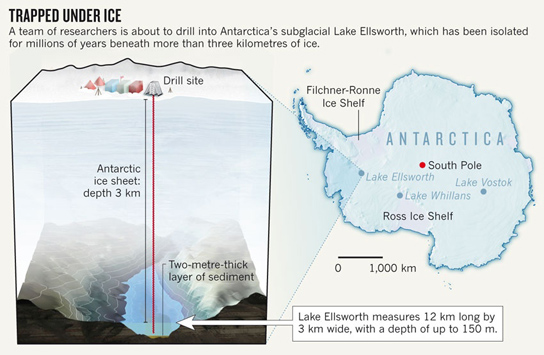British and American Teams Hunt for Life Under Antarctic Ice
November 22, 2012

A British field camp in Antarctica will soon host efforts to drill through the ice to reach Lake Ellsworth. Photo by BAS
Next week, UK glaciologists are heading to Lake Ellsworth to prepare for a new drilling stage that will start December 5. They hope to reach the lake and start examining sediments to find signs of life.
The team will try to understand the history of the West Antarctic Ice Sheet, which has the potential to reveal how the glacier has waxed and waned over time.
Roughly 380 subglacial lakes have been discovered and mapped in Antarctica, and they have been explored remotely with ice-penetrating radar, gravity measurements, and seismic sensors. The lakes were created by geothermal heat that melts the Antarctic ice from below. Gravity and pressure force the melt water to flow, and it collects under the ice.

Trapped under ice, infographic via Nature
If everything goes according to plan, Lake Ellsworth will be the second lake to be breached after Lake Vostok was reached in February. A US team is heading to Lake Whillans, a small, shallow body of water close to the edge of the Ross Ice Shelf. The discovery of exotic microbial life, which could have evolved untouched for millennia, is one of the aspects of this research. Scientists have already discovered bacteria that mine their energy from rocks and minerals, and they assume that there are many specialized microbes living underneath Antarctica.
The Russian team at Lake Vostok found evidence of heat-loving bacteria living in the bedrock surrounding the lake. The clues came from DNA in the sediment that was trapped in accretion ice. The upper layers of the lake itself appeared to be lifeless. No native microbes were turned up from a preliminary analysis of lake water.
Lake Ellsworth might have more microbes because it offers fewer hiding places. It’s 12 km in length, 3 km in width, with an average depth of about 150 meters. Vostok is 250 km long by 40 km in width, which makes it one of Earth’s largest freshwater bodies. It’s also nestled in a subglacial valley near the continental divide, where overlying ice moves at its slowest. The site, at about −30 °C, is twice as warm as the ice on the Vostok plateau in East Antarctica.
The goal is to reach Ellsworth in three days using a drill that will melt the ice with a high-pressure jet of water, heated up to 90 °C. Once the borehole is completed, the team has about 24 hours to deploy a sediment corer before the hole freezes over.
The equipment was prepared so that it doesn’t contaminate the lake with microbes from the surface. The main challenge involves completing all of the sampling operations within this very short window of time.
No comments:
Post a Comment